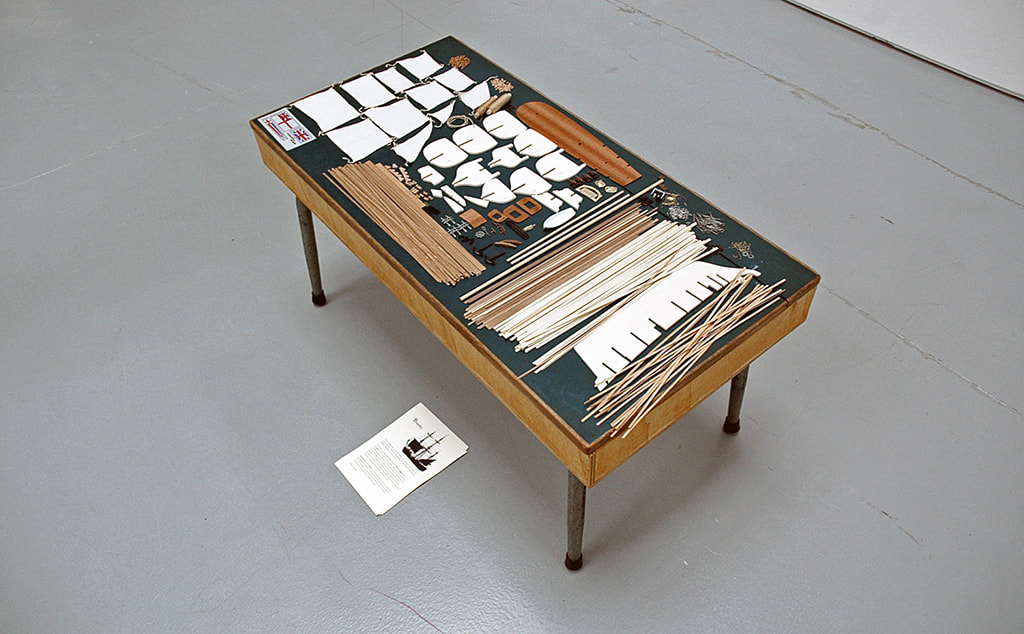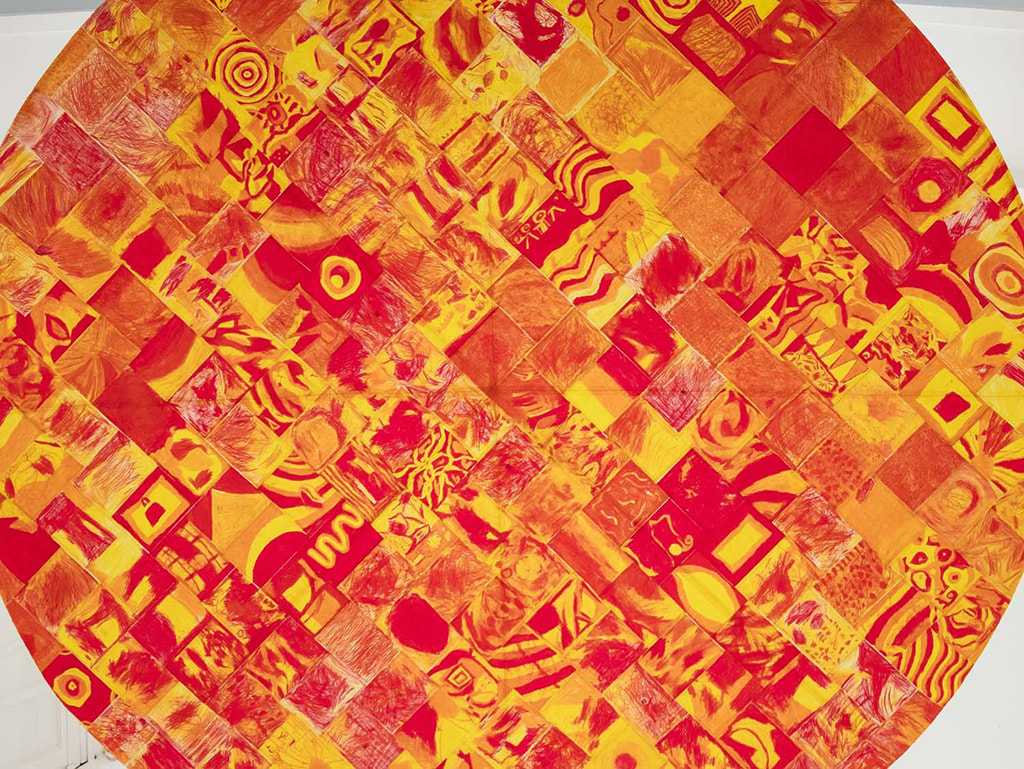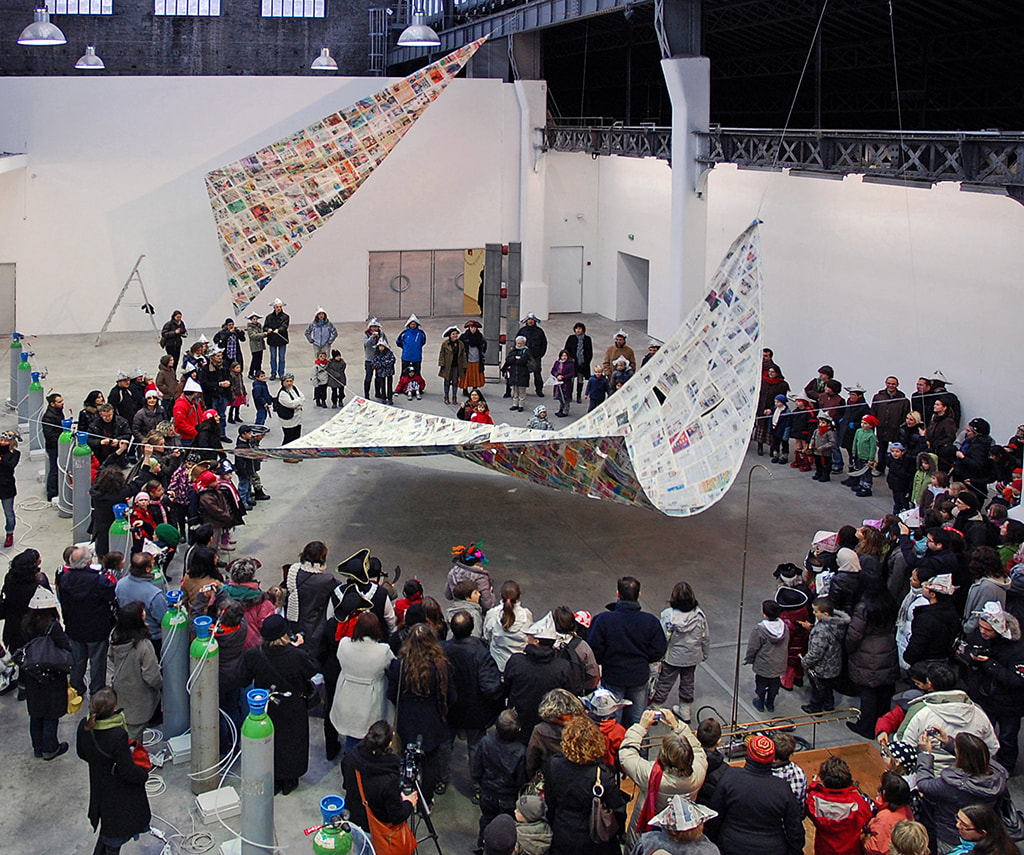By Gregory Hurcomb for Art Practical
Originally published October 31, 2017
“… for me it is not a problem, especially now, as to whether what I do is art or not. I use it to live, to have adventures (…)”
–Alighiero Boetti
–Alighiero Boetti
Perhaps this is the perfect quote to consider while contemplating the work of Italian artist Matteo Rubbi, who I recently had the opportunity to sit down with at the Montalvo Arts Center in Saratoga, California where Rubbi is currently an artist in residence. Our conversation focused primarily on his current project at Montalvo, as well as the artistic production of Voyages Dans La Mer Perdue (Journeys in the Lost Sea), a collaboratively built installation located in Delme, France. Rubbi’s work often attempts to recalibrate, recontextualize, and reimagine the past anew, so that the spectator and participant are actively engaged in the recreation of something that they may know about, but have yet to really understand through their own experiences. This recalibrated present is a present that understands human mysteries and stories as being more resolute, and more human. The humanity presented in Rubbi’s work is one that discovers itself through an idea of mythology and imagination directly connected to the body; his is a humanity where physical existence is amplified through adventure and curiosity of science and factual occurrences, and where meaning and truth are amorphous clouds of potential. Rubbi allows us to rediscover the world—to see it, and even touch, smell, hear, and taste it in unique and marvelous new ways…
Gregory Hurcomb: So, tell me a little bit about what you are currently working on at the Montalvo Artist in Residence program.
Matteo Rubbi: The main objective of my residency is to conduct research that will allow me to construct an island utopia. I’m exploring four stages of research for this project, the first being a book by Garci Rodríguez de Montalvo, a Spanish writer who some believe named the state of California. Rodríguez de Montalvo’s 16 th century novel talks about the imaginary island of California, which is inhabited only by black, Muslim, female warriors, and ruled by Queen Calafia. For me, this book is a point of departure, and I anticipate there being many layers of meaning for me to explore. The second stage of research will involve contact with institutions that research extraterrestrials and artificial intelligence, NASA, and an exploration of the technological future that encompasses Silicon Valley.
My third area of research will take me to the Tohono O’odham Nation in Arizona, south of Phoenix. I’m interested in this nation for two reasons: the first being that it is somewhat of an island, in that it doesn’t appear on the map of the United States, and is an autonomous nation surrounded by the United States on all sides. This is interesting to me because ideas of “utopia” are often linked to something that is missing from your reality. There is a labyrinth there, and its design depicts experiences and choices individuals make in their journey through life. The last area of research is the border between Arizona, California, and Mexico, the fence, and the desert of Sonora. There, my research will be more closely linked to the exploration of the border. If utopias are thought of as islands, conceptually and physically, they must also be places with a clear border. This obviously raises many questions—and I will not attempt to answer all of them, but instead explore them.
During my time here, I will also run three workshops in an alternative high school, and will be working with students who are in detention, who are young and in prison. The workshops will be shaped around a challenge to give a final form to this island. I’m sure that passing through this process will be quite challenging, and will give me another point of view on this question of “what is California?” What is California when it is not fancy and posh, but another side, another dimension?
Matteo Rubbi: The main objective of my residency is to conduct research that will allow me to construct an island utopia. I’m exploring four stages of research for this project, the first being a book by Garci Rodríguez de Montalvo, a Spanish writer who some believe named the state of California. Rodríguez de Montalvo’s 16 th century novel talks about the imaginary island of California, which is inhabited only by black, Muslim, female warriors, and ruled by Queen Calafia. For me, this book is a point of departure, and I anticipate there being many layers of meaning for me to explore. The second stage of research will involve contact with institutions that research extraterrestrials and artificial intelligence, NASA, and an exploration of the technological future that encompasses Silicon Valley.
My third area of research will take me to the Tohono O’odham Nation in Arizona, south of Phoenix. I’m interested in this nation for two reasons: the first being that it is somewhat of an island, in that it doesn’t appear on the map of the United States, and is an autonomous nation surrounded by the United States on all sides. This is interesting to me because ideas of “utopia” are often linked to something that is missing from your reality. There is a labyrinth there, and its design depicts experiences and choices individuals make in their journey through life. The last area of research is the border between Arizona, California, and Mexico, the fence, and the desert of Sonora. There, my research will be more closely linked to the exploration of the border. If utopias are thought of as islands, conceptually and physically, they must also be places with a clear border. This obviously raises many questions—and I will not attempt to answer all of them, but instead explore them.
During my time here, I will also run three workshops in an alternative high school, and will be working with students who are in detention, who are young and in prison. The workshops will be shaped around a challenge to give a final form to this island. I’m sure that passing through this process will be quite challenging, and will give me another point of view on this question of “what is California?” What is California when it is not fancy and posh, but another side, another dimension?
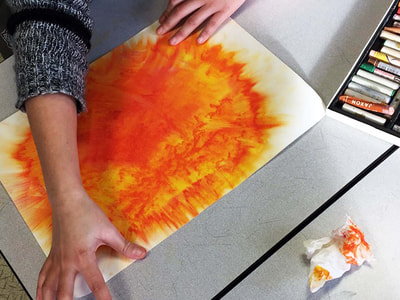
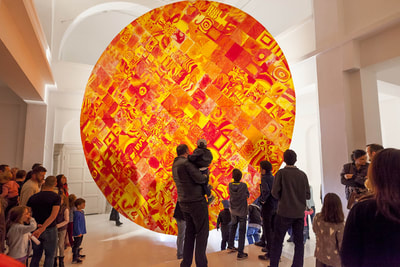
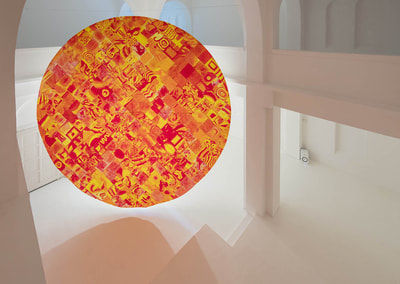
Matteo Rubbi. Voyages dans la mer perdue , 2017; Installation; 236 x 236 in. Courtesy of Centre d’Art Contemporain, La Synagogue de Delme. Photo: CAC – la synagogue de Delme.
GH: This project sounds incredibly complex and intricate, and one that explores many different aspects and worlds. Could you tell me about the last project that you completed in France, an equally multilayered construction involving a unique exhibition space, sound, and performance?
MR: Voyages Dans La Mer Perdue was recently installed at the Centre D’Art Contemporain la synagogue De Delme , a white cube gallery housed within a former synagogue in France. I worked with the preexisting architecture, which is now reconfigured to host several temporary exhibitions and fantastic programs in a small town of about 900 inhabitants. Delme, France is close to the border of Germany and Luxembourg—the border of several nations in fact—and in the past, all the most terrible wars were there. I was invited to collaborate and involve the population of this town, and to create all of the work for the exhibition there.
The idea was to start from something that is very local and very important for the economy of the place, which in this case was salt and the salt mines. Delme is full of salt that belonged to the Jurassic period, when the ocean was very close to this town, and over the centuries the salt became very precious economically—mining salt became the most important economy for the population, and while it is no longer, it is still very present in the culture. The community liked my idea of focusing on this aspect of their town, and thought it could be an easy way to connect to people from all different experiences. Of course, now Delme is very far from the sea, but I wanted to recreate the time when there would’ve been a sunset over the ocean, and to jump backwards.
MR: Voyages Dans La Mer Perdue was recently installed at the Centre D’Art Contemporain la synagogue De Delme , a white cube gallery housed within a former synagogue in France. I worked with the preexisting architecture, which is now reconfigured to host several temporary exhibitions and fantastic programs in a small town of about 900 inhabitants. Delme, France is close to the border of Germany and Luxembourg—the border of several nations in fact—and in the past, all the most terrible wars were there. I was invited to collaborate and involve the population of this town, and to create all of the work for the exhibition there.
The idea was to start from something that is very local and very important for the economy of the place, which in this case was salt and the salt mines. Delme is full of salt that belonged to the Jurassic period, when the ocean was very close to this town, and over the centuries the salt became very precious economically—mining salt became the most important economy for the population, and while it is no longer, it is still very present in the culture. The community liked my idea of focusing on this aspect of their town, and thought it could be an easy way to connect to people from all different experiences. Of course, now Delme is very far from the sea, but I wanted to recreate the time when there would’ve been a sunset over the ocean, and to jump backwards.
Matteo Rubbi. Model Kit H.M.S. Bounty , 2015; ARS Artist in Residency Show, Fondazione Pomodoro, Milan. Courtesy of the Artist.
I wanted to imagine how this sunset may have been; I took into consideration the sun, the sea, and the animals that were there, as well as creatures that would have been alive during this time period. I thought about how very red the sun would be when it was setting close to the horizon, and prepared a tutorial where each student was to invent a piece of the sun, like a puzzle, on thin, lightweight paper. The students used warm colored oil pastels, which have a certain brightness, and which create a lucid and oily quality. Each one of these pieces was put together to form the fragile sun, which I taped together and held up in the main gallery space, positioned in the West where the sun would set. Finished, the piece is more than six meters high, and is very light, like a small miracle in the entrance.
GH: What about the interaction with the Sun—how did visitors engage with it and with the space? Were there other elements of the project that you connected the viewer with?
GH: What about the interaction with the Sun—how did visitors engage with it and with the space? Were there other elements of the project that you connected the viewer with?
Matteo Rubbi. Voyages dans la mer perdue , 2017; Installation; 236 x 236 in. Courtesy of Centre d’Art Contemporain, La Synagogue de Delme. Photo: CAC – la synagogue de Delme.
MR: Viewers entered the space on the backside of this six-meter high paper sun, and we placed a small light to illuminate it. We blocked out all of the windows with wood, and the sun was lighted and shone all the time. The space was dark, but there was this reddish pinkish sun that created a very bright atmosphere. I still felt that we needed more experience for the senses, so I invited a musician that I loved; most of his practice is about soundscapes. Not a lot of the children of Delme have been to the sea because, in fact, the city is very far from it today. I wanted the children to be able to imagine the environment of Delme during the Jurassic period, when it was a tropical environment with a warm sea, many animals, and shells. We held over thirty workshops where the children were helped to imagine and create the sound, which eventually played in the same space as the sun.
I also asked the children to draw animals—but not standard animals, animals of their imagination. There was a real mix, including a blue lobster of sorts and a worm like creature, which might have been a caterpillar. I passed these drawings out first to high school-aged community members who interpreted the drawings and built upon them, and then on to artists and fashion designers who created actual costumes of the animals. Visitors to the show were invited to partake in the viewing of the artwork while wearing a costume. So, you could in effect, become an animal for the visit.
I also asked the children to draw animals—but not standard animals, animals of their imagination. There was a real mix, including a blue lobster of sorts and a worm like creature, which might have been a caterpillar. I passed these drawings out first to high school-aged community members who interpreted the drawings and built upon them, and then on to artists and fashion designers who created actual costumes of the animals. Visitors to the show were invited to partake in the viewing of the artwork while wearing a costume. So, you could in effect, become an animal for the visit.
Matteo Rubbi. Bounty, hoisting of the main topgallant staysail , 2010; installed at Centre National d’Art Contemporain, Le Magasin, Grenoble, France. Courtesy of the Artist.
GH: To round our conversation out, can you tell me something about yourself as an artist? What type of practitioner are you? And what are some themes and processes you hope to explore through your work?
MR: Well I’m not solely a community artist—though I do enjoy working on these types of projects, ones that involve schools and students. I was trained as a painter, and would consider myself a painter, though painting is a very complex issue today, overall. I don’t use any particular medium in my work, because I am concerned with achieving a certain aesthetic—the materiality, the composition, the touch, the feeling, and the form are all considerations. Even something like the audio of the sea, is a painting for me.
In my practice I am obsessed with proportion. How can I create, for instance, the sun, at a scale outside of how it is ordinarily experienced and considered? I am interested in the interconnection between art and science, and many of my projects deal with those intersections. I like to think about the two big theories of science—Einstein’s theory of relativity, and quantum physics, which looks at how the universe behaves to describe the smallest thing that can be described. Much of my work functions as a bridge between the two theories, which are conflicting. In my work there is storytelling, and there is an effort to create a journey between very small and very large things, and how our minds can arrive to imagine all the spaces in-between.
MR: Well I’m not solely a community artist—though I do enjoy working on these types of projects, ones that involve schools and students. I was trained as a painter, and would consider myself a painter, though painting is a very complex issue today, overall. I don’t use any particular medium in my work, because I am concerned with achieving a certain aesthetic—the materiality, the composition, the touch, the feeling, and the form are all considerations. Even something like the audio of the sea, is a painting for me.
In my practice I am obsessed with proportion. How can I create, for instance, the sun, at a scale outside of how it is ordinarily experienced and considered? I am interested in the interconnection between art and science, and many of my projects deal with those intersections. I like to think about the two big theories of science—Einstein’s theory of relativity, and quantum physics, which looks at how the universe behaves to describe the smallest thing that can be described. Much of my work functions as a bridge between the two theories, which are conflicting. In my work there is storytelling, and there is an effort to create a journey between very small and very large things, and how our minds can arrive to imagine all the spaces in-between.



